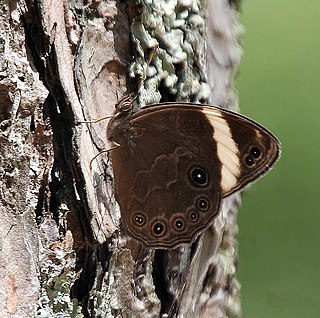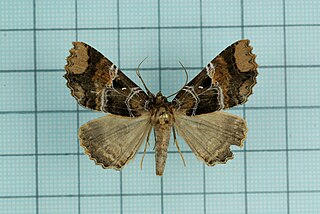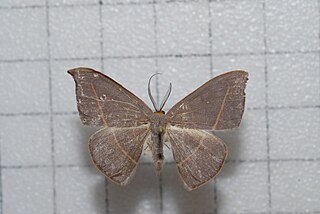
The Haast's eagle is an extinct species of eagle that once lived in the South Island of New Zealand, commonly accepted to be the pouakai of Maori legend. It was the largest eagle known to have existed, with an estimated weight of 15 kilograms (33 lb), compared to the 9 kg (20 lb) harpy eagle. Its massive size is explained as an evolutionary response to the size of its prey, the flightless moa, the largest of which could weigh 230 kg (510 lb). Haast's eagle became extinct around 1400, after the moa were hunted to extinction by the first Māori.

Lethe is a butterfly genus from the subfamily Satyrinae in the family Nymphalidae. The genus was erected by Jacob Hübner in 1819. It includes the treebrowns, woodbrowns, foresters and their relatives. The species in the genus Lethe occur in temperate-tropical southern and eastern Asia, up to Indonesia and in North America.

The genus Satyrium contains butterflies in the family Lycaenidae. The species of this genus are found in the Holarctic ecozone. For distribution information see Further reading "Le genre Satyrium".

Neptis is a large genus of butterflies of Old World tropics subtropics. They are commonly called sailer butterflies or sailers, or more precisely typical sailers to distinguish them from the related blue sailer (Pseudoneptis).

Leeches are segmented parasitic or predatory worms that comprise the subclass Hirudinea within the phylum Annelida. They are closely related to the oligochaetes, which include the earthworm, and like them have soft, muscular, segmented bodies that can lengthen and contract. Both groups are hermaphrodites and have a clitellum, but leeches typically differ from the oligochaetes in having suckers at both ends and in having ring markings that do not correspond with their internal segmentation. The body is muscular and relatively solid, and the coelom, the spacious body cavity found in other annelids, is reduced to small channels.
Katha is a genus of tiger moths in the family Erebidae. The genus was erected by Moore in 1878.
Mimudea is a genus of moths of the family Crambidae described by William Warren in 1892.

Pyrausta is a speciose genus of moths of the family Crambidae. The genus was erected by Franz von Paula Schrank in 1802.

Sypnoides is a genus of moths in the family Erebidae.

Somena is a genus of tussock moths in the family Erebidae. The genus was erected by Francis Walker in 1856.

Microblepsis is a genus of moths belonging to the subfamily Drepaninae.
Dactylosoma is a genus of parasitic alveolates of the phylum Apicomplexia.

Nossa is a genus of moths in the family Epicopeiidae. The genus was described by William Forsell Kirby in 1892.

Haemadipsa is a genus of leeches, with members commonly known as jawed land leeches. These annelids are known from subtropical and tropical regions around the Indian and Pacific Ocean. Well-known Haemadipsa are for example the Indian Leech and the yamabiru or Japanese Mountain Leech. Members of the genus feed on blood. They are troublesome to humans and animals especially because their bites result in prolonged bleeding.
Nossa moorei is a moth in the family Epicopeiidae first described by Henry John Elwes in 1890. It is found in the Indian state of Assam, Bhutan, and China.










